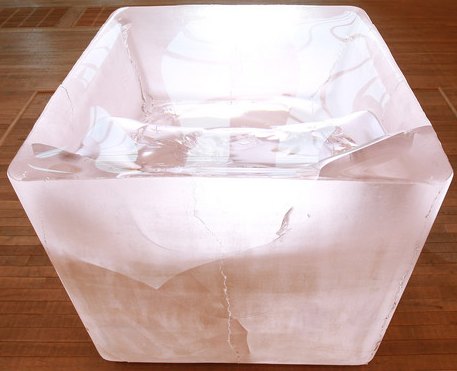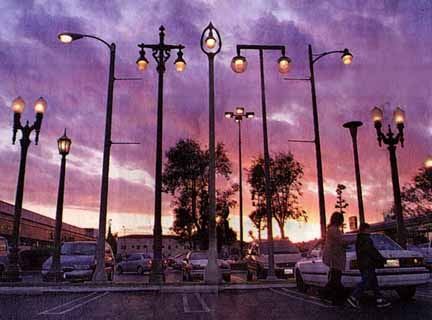Those people who make lists of the three or four artists who matter amid the multitude who don’t? Few include Bruce Nauman,
whose nonchalant profundity continues to be pioneering. List elitists
are almost invariably thinking of the market, as if art were just
another stock.
Roberta Smith’s review of Nauman’s current exhibit at the Philadelphia Museum of Art is splendid:
Even
after four and a half decades, Mr. Nauman still turns out videos,
sculptures, installation works and sound pieces that tend to be
stripped to the bone, no-frills, unfamiliar and even alien in form.
They don’t “present” as art, yet they lodge in the mind and won’t let
go, disorienting, irritating, inundating and exhilarating the senses.
And with time, the best Naumans make clear their art-ness, laying bare
life’s basic experiences, distilled and compressed.
(Small
gripe about the NYT: Its links policy is absurd. NYT links lead only to NYT stories. There’s no way to click through to something else, as if once
you’re in, you need nothing else. Yes, NYT, you are the best, but you’re not the only.)
More on Roberta Smith: John Perreault is absolutely right about her review
of Roni Horn. Smith missed Horn’s meaning by miles. Perreault is also
convincing on his thoughts about museum installations in general. (In
short: go lean.)
Horn – Pink Tons
 I’d
I’d
love to see the above 5 tons of pink glass in Seattle. That girly-girl
hit of Minimalism would be the elephant in our living room.We might stumble upon it and learn something.
Home team: Jen Graves’ essay on Miami topped anyone else’s.
But the annual art-world migration to Miami is not really about art.
It’s about the art world. About money, people-watching, and tropical
escape (the water is so salty off Miami Beach that a body floats
uncomfortably high in the cool December air). About rich people trying
to look smarter and vice versa. About, as Ben Davis has written, the
endless asking of the question “How are sales?” It almost feels beside
the point, like a bonus, that this is pretty much the only way to get
this much contemporary art in one place at one time–a painting in the
shape of a trench coat, a bin of musical garbage, a sculpture
consisting of an endless supply of white wrapped candies, fireworks
momentarily spelling the word “RECESSION” in the night sky, documentary
photographs of Texas prison lifers, a New York Times dipped in 24-karat gold, a video in which a young Iranian prostitute is tormented by men without faces (Shirin Neshat’s Zarin:
unforgettable), electronic billboards with messages such as “Confusing
yourself is a way to stay honest,” mesmerizing three-dimensional mirror
mosaics by an 85-year-old Iranian woman (Monir Shahroudy
Farmanfarmaian), a male mannequin with a lifelike crotch, a performance
in memory of the Tlatelolco student massacre in Mexico, graffiti on the
streets and in the galleries, drippy ceramics (by Seattle’s Jeffry
Mitchell), droopy textiles (by Josh Faught, based in Eugene, Oregon,
and recent Seattle Art Museum Betty Bowen Award winner), shoe-shine
stations painted like shrines, geometric abstractions made in thick,
silvery pencil. That and Picassos, Warhols, Duchamps, Ruschas, Flavins,
Richters, and even, this year, a religious painting by the
turn-of-the-20th-century Belgian James Ensor, whose retrospective this
year at the Museum of Modern Art was a sleeper hit. And paintings
(primary-colored, splashy) by Sylvester Stallone.
I hope the male mannequin with a lifelike crotch is Charles Ray’s. Otherwise, do your own work, anonymous artist mentioned in passing by Jen Graves.
What artists read: This month Tyler Green began a series on what featured artists read. Great idea, but sometimes I don’t want to know. Reading that Kate Shepard values most a book by Mary Baker Eddy handed me a problem that I don’t need. When looking at Shepard’s work, I’m going to have to force myself to forget that she’s a fall-for-anything fool. If artists I admire vote Republican, drive a Hummer, believe that civil rights need not include gays and lesbians or that the faithful can pray away cancer, I don’t want to know it. Jackson Pollock had the right idea. He kept what he was reading locked away, lest visitors drawn from that information conclusions that distract them from the work.
Hey Hey We’re the Monkeys: On a hopeful note, Terry Pratchett, wine glass in hand, held forth on stage about the state of things:
We
are shaped by the universe to be its consciousness. We tell the
universe what it is. …I find it more interesting (than religion) that
a bunch of monkeys climbed down from their trees to build this and
build that, to build everything. We’re monkeys. Our heritage is (when)
in difficulties to climb a tree and throw shit at other trees. That’s
so much more interesting than being a fallen angel…The story of
evolution is more interesting than anything in the Bible. It teaches us
that stars are not important. Street lamps are important. As far as we
know, there are only a few million of them in the universe. And they
were built by monkeys. Admittedly, we do err, as when we made Tony
Blair prime minster. But given where we started from, crawling up some
beach somewhere, we actually haven’t done that badly.
Very
nice about street lamps, but Pratchett might want to reread Milton.
Christianity doesn’t claim that we are fallen angels. The fallen angels
are devils, the greatest being Satan, the hero of Paradise Lost. Landing in the abyss, he asked, “What do mine eyes with grief behold?” A monkey wrote that. Impressive, for a monkey.
Back to street lamps. Sheila Klein’s Vermonica.
 Installed in 1992, it predates by 16 years a similar piece in the same town by the great Chris Burden. (Story here.) Monkeys have the unfortunate habit of copying each other and giving the more famous monkey all the credit. Los Angeles has room for both, but for LA critics to treat hers as if it doesn’t exist is weird.
Installed in 1992, it predates by 16 years a similar piece in the same town by the great Chris Burden. (Story here.) Monkeys have the unfortunate habit of copying each other and giving the more famous monkey all the credit. Los Angeles has room for both, but for LA critics to treat hers as if it doesn’t exist is weird.



Pretty good post, for a monkey.
Sheila Klein wuz robbed! Seattle to the rescue! Call out those LA art critics! Shame! Shame! (Calm down, Regina.)
Regina, Graves wrote a great essay on Miami but have you been following Joanne Mattera’s posts on Miami? It’s the most visually comprehensive I’ve seen, and in a way, bringing it all back to the art.
Hi Sharon. Yes, I’ve read Joanne Mattera’s posts on the subject with pleasure. For a you-were-there overview, however, Jen walked away with it. R